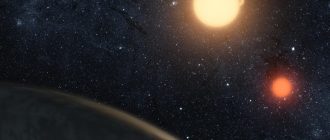
In the very early years of the solar system, the early Earth took much less time to form than we previously thought.
According to a new analysis of iron isotopes found in meteorites, it took most of the Earth only 5 million years to come together – several times less than current models suggest.
This revision is a significant contribution to our current understanding of planetary formation, suggesting that the mechanisms can be more varied than we think, even between planets of the same type located in the same area – rocky planets such as Mars and Earth.
You see, we're not 100% sure how planets form. Astronomers have a pretty good general idea, but the finer details … well, they're pretty hard to see in action.
The broad strokes of the planetary formation process are associated with the formation of the star itself. Stars form when a lump in a cloud of dust and gas gathers under its own gravity and begins to spin. This causes the surrounding dust and gas to circulate around it, like water circulating around a drain.
As it spins, all of this material forms a flat disk that feeds the growing star. But not the entire disk will be absorbed – what remains is called the protoplanetary disk, and it continues to form planets; that is why all the planets of the solar system are roughly located on a flat plane around the sun.
When it comes to planetary formation, it is believed that tiny particles of dust and rock in the disk will electrostatically cling to each other. Then, as they grow in size, so does their gravitational force. They begin to attract other clusters through random interactions and collisions, increasing in size until they become a whole planet.
It was believed that for the Earth this process took tens of millions of years. But the isotopes of iron in the Earth's mantle, according to scientists at the University of Copenhagen in Denmark, show the opposite.
In its composition, the Earth differs from other bodies in the solar system. Earth, Moon, Mars, meteorites – they all contain natural isotopes of iron such as Fe-56 and the lighter Fe-54. But the Moon, Mars and most meteorites have the same number, while the Earth has significantly less Fe-54.
The only other cosmic body that has a composition similar to that of Earth is a rare type of meteorite called CI chondrites. The interesting thing about these meteorites is that they have a composition similar to the solar system as a whole.
Imagine if you got all the ingredients for a salad. Mix them all together in one big pot – this is the protoplanetary disk and then the solar system. But if you scattered your ingredients in several small pots with different proportions of each ingredient – now you have separate planets and asteroids.
What makes CI chondrites special is that, by this analogy, they are like little tiny pots containing the initial proportions of ingredients. So, having one of these cosmic rocks handy is like having a microcosm of dust swirling in a protoplanetary disk at the dawn of the solar system, 4.6 billion years ago.
According to modern models of planetary formation, if matter were simply mixed with each other, the iron content in the Earth's mantle would be representative of a mixture of all kinds of meteorites with a higher Fe-54 content.
The fact that the composition of our planet is comparable only to CI-chondrites suggests a different formation model. The researchers believe that instead of piling up, Earth's iron core formed earlier in a rain of cosmic dust – a faster process than accretion of larger rocks. During this time, an iron core was formed.
Then, when the solar system cooled down, after the first few hundred thousand years, CI dust from the far edge could migrate inward, to where the Earth was forming. It is scattered all over the Earth.
The researchers concluded that since the formation of the protoplanetary disk – and the large amount of dust in it that could have fallen to Earth – only lasted about 5 million years, the Earth must have accreted during this time period, the researchers conclude.
“This added CI dust overprinted the composition of the iron in the Earth's mantle, which is only possible if most of the previous iron was already in the core,” explained geologist Martin Schiller of the University of Copenhagen.
This not only broadens our understanding of planetary formation, but can also affect our understanding of life in the universe. It is possible that this kind of planetary formation is a prerequisite for conditions conducive to life.
“We now know that planetary formation is happening everywhere. We have common mechanisms that work and create planetary systems. When we understand these mechanisms in our own solar system, we can draw similar conclusions about other planetary systems in the galaxy, 'said cosmochemist Martin Bizzarro of the University of Copenhagen.
The study was published in the journal Science Advances.
Sources: Photo: NASA / JPL






